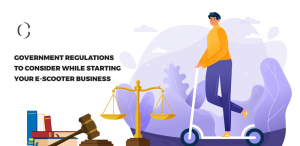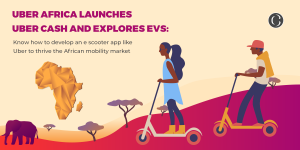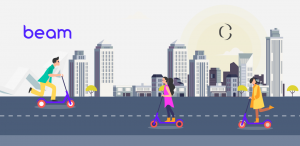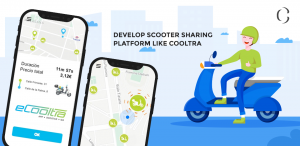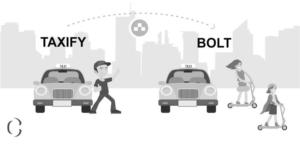E scooter app development: Importance of Geo-fencing and its importance in the e-scooter app

The dockless electric scooters are adopting new technologies to make the scooter-sharing easier. The electric scooter rental companies are focused on areas with limited transit access that could benefit from a new mobility option. The coverage zone comprises of several residential and commercial densities, and economically and ethnically diverse communities.
Earlier this year, a surge in electric scooter firms was witnessed in the San Francisco Bay Area cities without the consent of the municipalities, hinting the city of San Jose to analyse fighting technology with technology to restrain these dockless scooters as they rush around the city. This led to the consideration of working on geofencing to figure out how to get the e-scooters to de-activate on sidewalks but turn on when they are actually in bike lanes quoted the San Jose Mayor Sam Liccardo at the Mayor Summit.
The charm of GPS may help everyone to get a technological solution. Geofencing is being considered as a possible solution to the circumstances where people riding dockless scooters, as well as dockless bicycles, are dashing through areas where pedestrians walk, or when riders drop them in doorways of businesses — or even in city lakes.
What is Geo-fencing?
A geofencing is a virtual perimeter for a real-world geographic area. It can be dynamically generated in a radius around some point location. A geofencing involves a location-aware device of a location-based service (LBS) user entering or exiting a geo-fence.
This action could trigger a warning to the device’s user and could send a message to the geo-fence operator. This information could contain the location of the device and can be sent to a smartphone or email account. Geofencing is helpful in a security strategy model as it provides security when there are predefined borders for the e-scooters done by positioning technology attached to a server.
Pilot E-scooters in Chicago
In assessing the influence of scooters in Chicago, important equity questions have to be approached. The laws of the pilot need vendors to have to adhere to equity criteria. The companies are asked to offer services for people without credit cards or smartphones. Also, the company owners have to submit a plan for hiring local residents and working with local businesses.
To ensure user safety, vendors will be expected to conduct an education campaign to assure users know to safely drive and correctly park the e-scooters. This will involve in-app educational materials for first-time users. Users will also be asked to take a post-ride photo as proof that they have parked their scooters correctly and out of the way of pedestrians.
The e-scooters must be provided with a warning bell, front white light, rear red light, and hand and foot brakes. They must also have the contact information and a 24/7 customer service phone number. The city is moving forward with the pilot program and Lime e-scooters is recently submitting the application offering value to Chicago by providing a more affordable, equitable transportation solution that helps get people out of cars.
The geofencing technology will stop the users if they try to leave the pilot zone! Looking at the user safety scenarios across the world, geofencing seems to be the answer for the cities where e-scooters are facing a lot of challenges.
Technical aspects of geofencing
Geofencing connects recognition of the user’s current location with information of the user’s vicinity to locations that may be of concern. While marking the location of interest, a developer needs to specify its latitude and longitude. A radius needs to be added to adjust the proximity for the location. The latitude, longitude, and radius determine a geofence, generating a circular area, or fence, around the location of interest.
The e-scooter companies can have multiple active geofences with a limit of 100 per app, per device user. They can ask the location services to send them the entrance and exit events for every geofence.
As an e-scooter company owner, you can ask for a specific duration within the geofence area to wait, or dwell, before triggering an event. The duration can be limited to a certain duration of any geofence by specifying an expiration duration in milliseconds.
While requesting geofencing, the first step is to request the necessary permission. To start using geofencing, you need to request ACCESS_FINE_LOCATION through your app. The app targeting Android 10 (API level 29) or higher needs to request ACCESS_BACKGROUND_LOCATION.
While requesting the necessary permissions you can add them as child elements of the <manifest> element in your app manifest:
<uses-permission android:name=”android.permission.ACCESS_FINE_LOCATION”/>
<!– Required if your app targets Android 10 (API level 29) or higher –>
<uses-permission android:name=”android.permission.ACCESS_BACKGROUND_LOCATION”/>
You can also use a BroadcastReceiver to listen for geofence transitions.
Your app is required to create and add geofences utilising the location API’s builder class for building Geofence objects, and the convenience class for adding them. In order to manage the intents sent from Location Services when geofence transitions happen, a PendingIntent can be defined.
Later comes creating the object and handling geofencing transitions.
The best practices for geofencing are as follows:
Lessen power consumption
Using these techniques can help to optimize power consumption in your apps that use geofencing:
- Set the notification responsiveness to a greater value. It enhances power consumption by improving the latency of geofence alerts.
- Using a larger geofence radius for locations where a user spends a significant amount of time, such as home or work can prove more efficient. It decreases the frequency at which the app checks for entrance or exit, dramatically lowering overall power consumption.
Choosing the optimal radius for your geofence
The minimum radius of the geofence should be set between 100 – 150 meters to get better results. The location accuracy is between 20 – 50 meters whenever Wi-Fi is available. The accuracy range can be as small as 5 meters when an indoor location is available. In rural areas, the location accuracy degrades.
Dwell transition model to lessen alert spam
The dwelling alert is sent only in the case when the user halts inside a geofence for a certain time. You can determine the term by setting a loitering delay.
Want to develop an e-scooter app with the geofencing feature? Contact us.
Geofencing is great when it comes to providing users with a safe and secure way of riding the e-scooters. We can help you to include it in your e-scooter app to enhance your micro-mobility solutions.
Check out our e-scooter app development page or connect with us to know more about the e-scooter white label solution- Rohak and the other technologies to make your app stand out in the competition.



